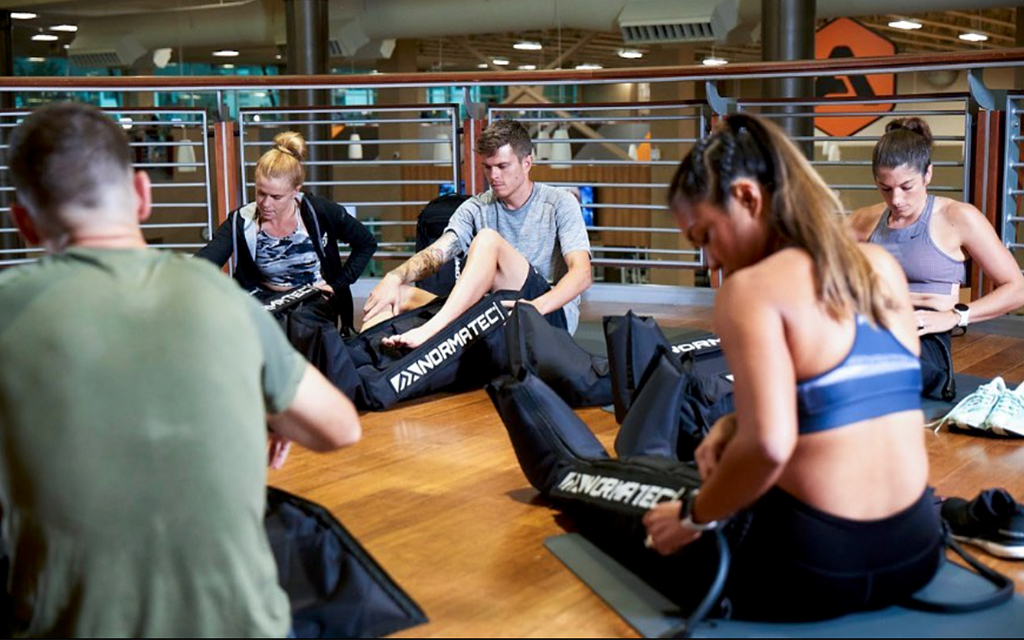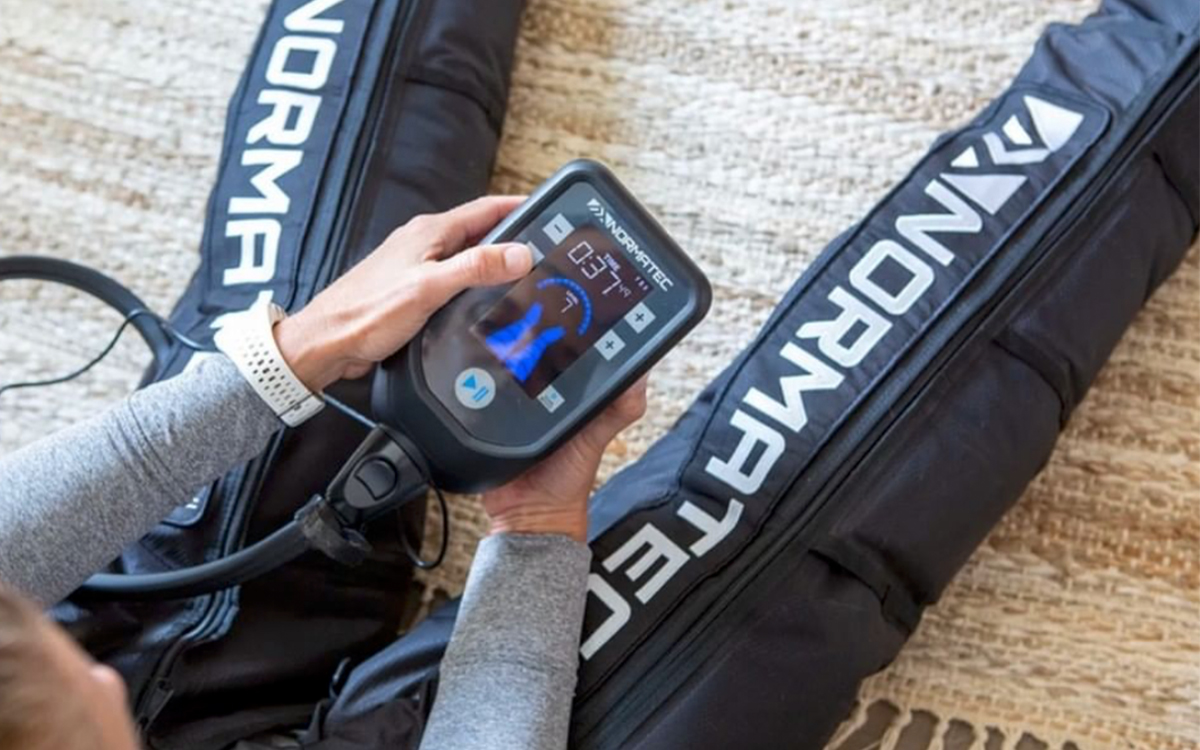An incomplete list of elite athletes who have been photographed wearing, assembling or carrying a version of the NormaTec Recovery System: Russell Wilson, Anthony Davis, Mo Farah, Rickie Fowler, Chloe Kim, Giannis Antetokounmpo, Mookie Betts, Nastia Liukin, Tua Tagovailoa, Tiger Woods, Zoë McDougall, Drew Brees and Steph Curry.
Back in 1998, when physician bioengineer Dr. Laura F. Jacobs patented her Sequential Pulse pneumatic waveform — a form of pulse compression that encourages venous blood flow throughout the body — she imagined the technology as a non-invasive treatment for circulation-related disorders. The idea was that adults with peripheral vascular diseases, whose blood vessels are prone to blockages or spasms, could use a massage system that clamps down on afflicted areas (sort of like a blood-pressure monitor) and “milks” the blood to the heart before sending it back, refreshed, to the outer reaches of the limbs.
In 2002, Dr. Jacobs released the NormaTec Pneumatic Compression Device for that purpose.
Over the next five years, though, the sports world’s quickest and strongest caught wind of the revolutionary massage system, and began using it to warm up their muscles before workouts as well as catalyze recovery in the hobbling hours thereafter. Like any smart, open-minded venture, NormaTec leaned into the unexpected success; the brand opened its Athlete Technologies division in 2007, and began what’s now a 13-year run of dominance in leg, hip and shoulder recovery.
This isn’t a case of athletes peddling dubious technology for kickbacks on Instagram. NormaTec systems are institutionally trusted. The CEO of USA Track and Field calls NormaTec a “crucial partner” for its athletes. Ironman champions swear by it. The University of Alabama, Los Angeles Rams and Boston Ballet all rely on NormaTec systems.

But while the systems have been a near-expected mainstay in professional trainer’s rooms for a while now, the general population hasn’t had much experience with NormaTec’s boots or shoulder pads. When I first saw a line of 20-somethings sliding into the goofy nylon tubes at Finish Line Physical Therapy in New York’s Flatiron District (a runner’s recovery haven with anti-gravity treadmills, cryotherapy chambers and infrared saunas), I muttered “The hell …?”
That strange blend of ubiquity and mystery has something to do with the price point. NormaTech systems, in their many variations, hover around $1,300. But their recent rise in popularity mirrors a more general public awakening to the idea of recovery fitness. For years, laymen gym-goers and weekend warriors eschewed active recovery as an integral function in their fitness routines. Aside from some half-baked stretching or the occasional 15 minutes in a steam room or sauna, most athletes neglect to take the time in between workouts as seriously as they do PR times.
That, of course, is no longer the case. Preventive remedies like percussive therapy, classes for marathon runners meant to ward off injury, posture-correcting pilates, post-workout bathhouses and a whole host of other recovery-oriented rituals finally have the common man trying their hand at what the best athletes in the world have been practicing for a long time. And NormaTech sleeves are deservedly a part of this movement.
Related:
Recovery Training Is the Most Overlooked Part of Your Workout
Percussive Therapy Is the Rare Fitness Innovation That Actually Works
I recently tested out a pair of the Pulse 2.0 Recovery System. I’m 6’3″ — which puts me at the top of the height variance for the Standard unit (5’3″-6’3″) — but had little trouble slipping the sleeves on over each leg. They connect via two outlet hoses to a control unit, which was tremendously easy to use. Pick a length of massage (I chose 30 minutes), select a level of intensity (I chose 5; there are 7 levels) and sit back. While the tubes tightened around my legs, starting with my ankles, then making their way up my calves and thighs, I tapped away at a project on my computer and sipped tea.
The system has a preset pacing algorithm that manages to address every corner of your legs several times over the course of 30 minutes. It’s not a light squeeze, but it’s not painful either. My thoroughly unscientific review: you can feel tension being filtered up and out. I juiced it up to 7 for the last few minutes, then shut it down and removed my legs. I’d skied then worked my legs hard in the gym on consecutive days before using the sleeves, so they’d hated me for 48 hours. But I felt light and easy after the session, like I’d spent an hour in a hot tub.
I cover fitness for a living and make a point to stay active throughout the week, but my training regimen has more in common with a fourth grader’s gym class than the routines of Drew Brees or Nastia Liukin. That said, the amount or intensity of physical activity in your life should not disincline you from engaging with intermittent pneumatic compression (the official name for the therapy). We write a lot about low back pain, aging knees, spinal cords afflicted by old injuries or a sedentary lifestyle — this machine is for folks who suffer from those afflictions, too. It’s for pregnant women with exhausted ankles, or groundskeepers who throw a shovel around all day.
The price may not be democratized quite yet (though, let’s be honest, considering the base clientele it could be way worse), but the information in recovery fitness certainly has been. If you bring home a system, make a point to use it either A) in the morning or for 10 minutes before a workout as a way of readying the muscles and ligaments for physical activity, or B) like I did, in the evening, for anywhere from 30 minutes to an hour, as a way of beginning the crucial recovery process and helping your body heal.
Find the full range of NormaTec systems here. And in case you’re still utterly convinced of their value, looks like Arya used them to help her kill the Night King.
Whether you’re looking to get into shape, or just get out of a funk, The Charge has got you covered. Sign up for our new wellness newsletter today.
























